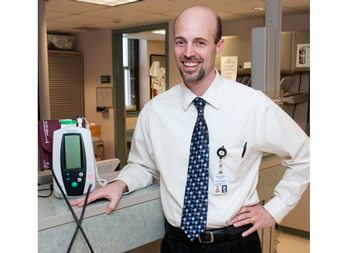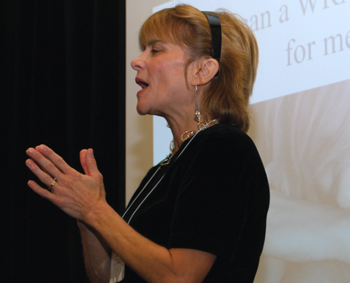Barcode medication administration assures the “six rights” are confirmed
 |
| Amy Sheely, RN, on 6 South at WellSpan York Hospital, uses barcode technology to match patient Joe Sciarrabba with the right medication. |
Beginning April 1 with WellSpan York Hospital, WellSpan’s three hospitals will begin to implement Bar Code Medication Administration (BCMA).
This creates a closed- loop process that improves patient safety by matching the right patient with the right medication. BCMA enables nurses to scan patients’ arm bands along with their medication to ensure accuracy in dosage, delivery and timing.
The use of barcodes provides a valuable verification of medication administration by assuring that the “six rights” are confirmed — right patient, right medication, right dose, right time, right route and right documentation of administration.
Now, nurses can scan a patient’s armband and then the medication to validate it is the correct product.
According to the Institute of Medicine, the use of this technology has shown it dramatically reduces medication administration errors. When used properly BCMA is an effective means to prevent medication administration errors.
The addition of barcode verification at the point-of-care has the potential to significantly increase patient safety for hospital patients.
“We are always looking for ways to utilize technology to improve patient safety,” said Kris O’Shea, vice president, clinical transformation and patient care services, WellSpan.
“Although barcode technology has been present in our hospitals for some time now in support of positive patient identification during the medication administration process, the implementation of barcode medication administration enhances the sophistication of this process by coupling the positive identification of the patient to the correct medication order and product. The end result is a medication use process that is confidence-inspiring for nurses and patients alike.”
Administering medication can be cumbersome
Traditionally, administering medication to patients can be a cumbersome process that entails transcribing information by hand, comparing this information against the patient chart, visually checking to confirm patient identity, and transcribing patient information back into the patient record. By its nature, it’s a process that takes caregivers away from their patients in order to perform administrative processes.
The traditional medication administration system is also prone to human error, which occasionally results in misidentification of patients and delivery of incorrect medications and/or dosage.
BCMA will help clinicians by improving workflow and eliminating workarounds that can lead to documentation errors and to potential adverse medication errors. Two WellSpan York Hospital units, 5 South and 6 South, recently completed a successful two-month BCMA pilot.
“It’s really been easy to learn the system and become comfortable using it,” said Amy Sheely, RN, 6 South at WellSpan York Hospital.
“There are times when the technology actually catches you to make sure that your dosage and other vital information are correct.”
Dawn Wise, RN, 6 South at WellSpan York Hospital, added, “The thing I really like about the new system is that we are ensuring the right patient, right medication, right time and right dose by not only visually checking arm bands and medication. Because we have to scan the patient and medication, we are getting the extra safety insurance for our patients.”
WellSpan York Hospital’s implementation will be followed by the WellSpan Surgery & Rehabilitation Hospital on May 6 and by WellSpan Gettysburg Hospital on May 28.




 Prostate cancer is the most frequently diagnosed form of noncutaneous cancer in men, and the second leading cause of cancer death in men. Its elusiveness stems from an unusually slow growth process that is typically symptom-free, although it does become aggressive in one-third of cases.
Prostate cancer is the most frequently diagnosed form of noncutaneous cancer in men, and the second leading cause of cancer death in men. Its elusiveness stems from an unusually slow growth process that is typically symptom-free, although it does become aggressive in one-third of cases. Libraries, movie theaters and dance recitals are places where you expect it to be quiet. WellSpan hopes to add its hospitals to the list.
Libraries, movie theaters and dance recitals are places where you expect it to be quiet. WellSpan hopes to add its hospitals to the list. The Board of Directors of WellSpan Health has announced the appointment of Kevin H. Mosser, M.D., as the next president and chief executive officer of the community-based, non-profit health care organization, effective October 1, 2013.
The Board of Directors of WellSpan Health has announced the appointment of Kevin H. Mosser, M.D., as the next president and chief executive officer of the community-based, non-profit health care organization, effective October 1, 2013. 
 National Hospital and Health System Week (May 12-18) is an appropriate time to look at the impact health care and WellSpan have on the state and the region.
National Hospital and Health System Week (May 12-18) is an appropriate time to look at the impact health care and WellSpan have on the state and the region.
 MyWellSpan reached 35,000 enrollees in mid-May.
MyWellSpan reached 35,000 enrollees in mid-May. “Many patients have challenges in addition to their illness,” said Chris Echterling, MD, associate medical director for quality and innovation, WellSpan Medical Group.
“Many patients have challenges in addition to their illness,” said Chris Echterling, MD, associate medical director for quality and innovation, WellSpan Medical Group. Gordon Zubrod, MD, assistant residency program director for the WellSpan York Hospital Family Medicine Residency Program, has been named “Exemplary Teacher of the Year” by the Pennsylvania Association of Family Physicians (PAFP).
Gordon Zubrod, MD, assistant residency program director for the WellSpan York Hospital Family Medicine Residency Program, has been named “Exemplary Teacher of the Year” by the Pennsylvania Association of Family Physicians (PAFP).
